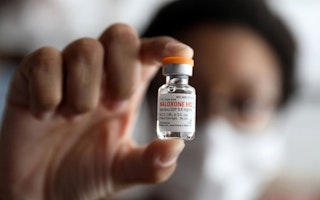What Do Torture and Drugs Have in Common?
By Roxanne Saucier
June 26 marks the UN’s annual International Day in Support of Victims of Torture. Interestingly, the UN has also designated that date as International Day against Drug Abuse and Illicit Trafficking. At first, the two occasions may seem to have little in common. Unfortunately, that is not the case for many people who use drugs across the globe.
Over the past decade, governments have increasingly turned to arbitrary detention, cruelty, and even torture in order to combat drug abuse. This so-called rehabilitation rarely resembles the evidence-based drug treatment people deserve— a supportive experience, entered into voluntarily and with full consent to the treatment plan.
Two new publications issued by the Campaign to Stop Torture in Health Care, a coalition led by the Open Society Foundations, document the abuses that people detained in the name of drug treatment regularly suffer. The first, Treated With Cruelty: Abuses in the Name of Drug Rehabilitation, is a compilation of personal testimonies of detainees in Russia, China, Cambodia, and Mexico.
Consider how one detainee describes what treatment in a government-run “rehabilitation center” in China looks like. Forced to work more than 12 hours in order to meet an exhausting work quota, his “treatment” sounds more like a forced labor camp. If he didn’t meet his daily production quota of copper-threaded magnets, he could expect a severe beating at day’s end.
“Treatment” in Chinese centers typically lasts two to six years.
In Cambodia, Jin tells his story of being picked up by police while he was sitting on the side of a street, talking to a friend. Though he wasn’t given a trial or a sentence, he was charged as a drug user and locked in a room with some 50 other men and boys, ages 12 through 50. He was denied medication to help him through agonizing withdrawal. Instead, he was beaten and forced to work.
Outside of Asia—where governments mainly run these detention facilities— other countries instead have private establishments that are equally abusive. In these places, government officials normally turn a blind eye to these centers, usually run by vigilantes, failing to regulate or even investigate them after allegations of abuse.
Russia’s City Without Drugs Foundation is famous for its brutal treatment of people who use drugs. People are often kidnapped, held against their will, and then forced to sign consent forms, a practice that has caused the government to investigate it in the past. In October 2010, the head of a regional branch was sentenced to more than three years in prison for torturing people in the rehabilitation center, but his sentence was later recalled and he was merely placed on probation.
The foundation’s centers, located in several Russian cities, remain open and receive broad public support. What’s more, new legislation in the Russian Duma calls for drug users to be forced into treatment.
In Mexico, Adriana tells the story of her brother, Francisco. Her family sent him away to a center that promised to help with his crack use. He relapsed after three months, but told his sister “Please, don’t put me [back] there, you’ll regret it for the rest of your life.” Five days after he was readmitted to the center, he was dead, the result of beatings and abuse by center management.
It is hard to read these accounts and not consider them acts of torture, or at least cruel, inhuman and degrading treatment. These terms, however, have explicit definitions under international law. In our second book, Treatment or Torture? Applying International Human Rights Standards to Drug Rehabilitation Centers, the authors make the case that such experiences do, in fact, meet the required legal definition. This analysis will be invaluable to anyone bringing cases of torture in drug detention to international, regional, or domestic bodies charged with preventing or prosecuting torture.
It is clear that abusive drug treatment centers should be shut down immediately. Instead, we need better access to community-based, voluntary drug treatment services that have been proven to work, such as methadone and buprenorphine treatment programs.
Yet while we should push for real treatment, we shouldn’t wait for it either. Many people are detained in these centers without clinical assessment, because of one positive urine test, or because the government wants to “clean the streets” of homeless and poor people. Detaining people in holding pens and labor camps isn’t a worthwhile way to address either poverty or addiction.
This June 26, let’s celebrate both international days by joining the call for governments to close abusive drug treatment centers and redirect our efforts to address the root causes of drug addiction and abuse.
Roxanne Saucier is a researcher and analyst for the Open Society Public Health Program.

